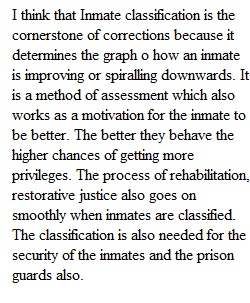


Q How the inmates are classified gives a lot of information at the first place. There are certain things on which the classification level depends. It depends on the term of his sentence, the way he is behaving in the prison, the crime he has committed etc. The custody levels are restrictive and non-restrictive in nature depending on the behaviour of the offender. On an institutional level the classifications are name 6 types where the most serious is Administrative segregation followed by General Population Level 5, Level 4, Level 3, Level 2 and Level 1. These are also known as G5, G4, G3, G2, G1. Again, in the state systems the classification become somewhat like this- Special Management, General Population Level 5, Level 4, Level 3, Level 2 and Level 1 which is also known as J5, J4, J3, J2, J1. The classification is done so that risk elements are separated from the general population. The whole thing depends on the way an inmate behaves and that determines in which category he will be kept and what privileges will he get (Pierce, 2016).
View Related Questions